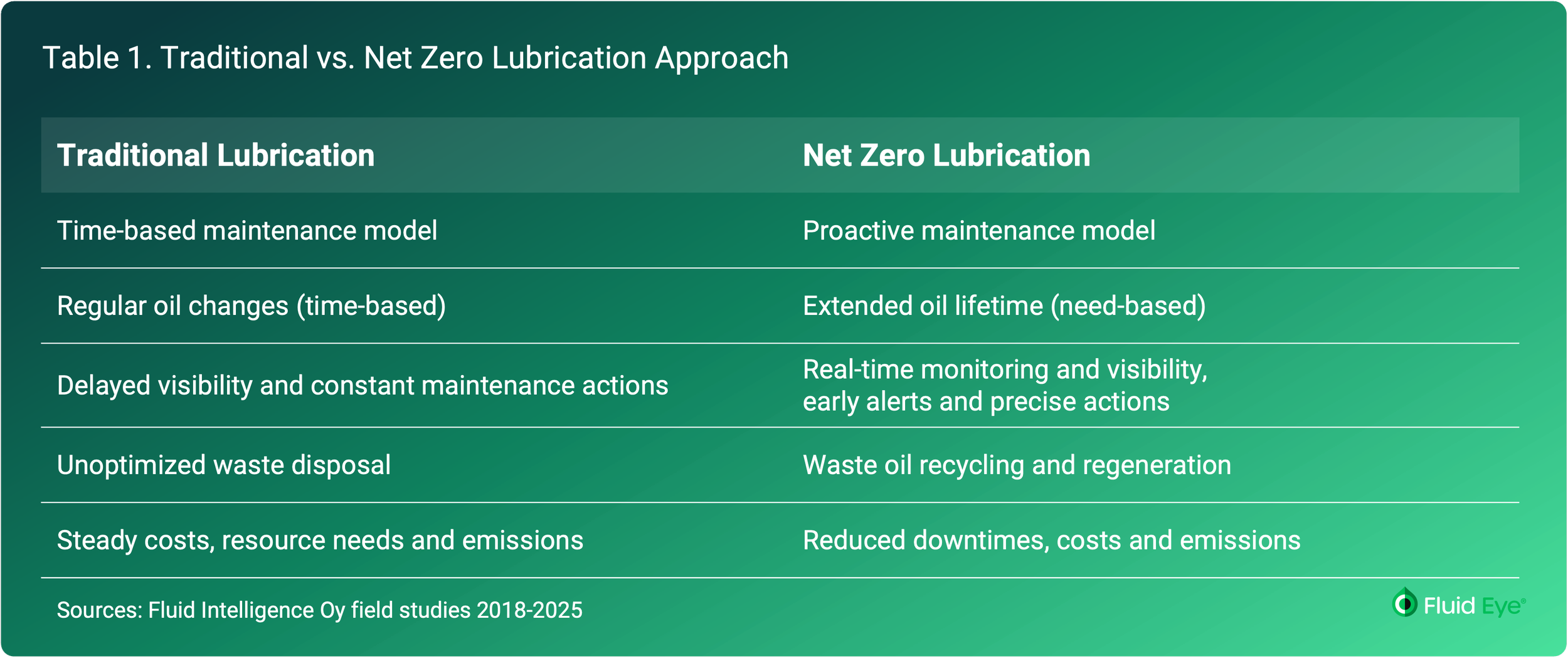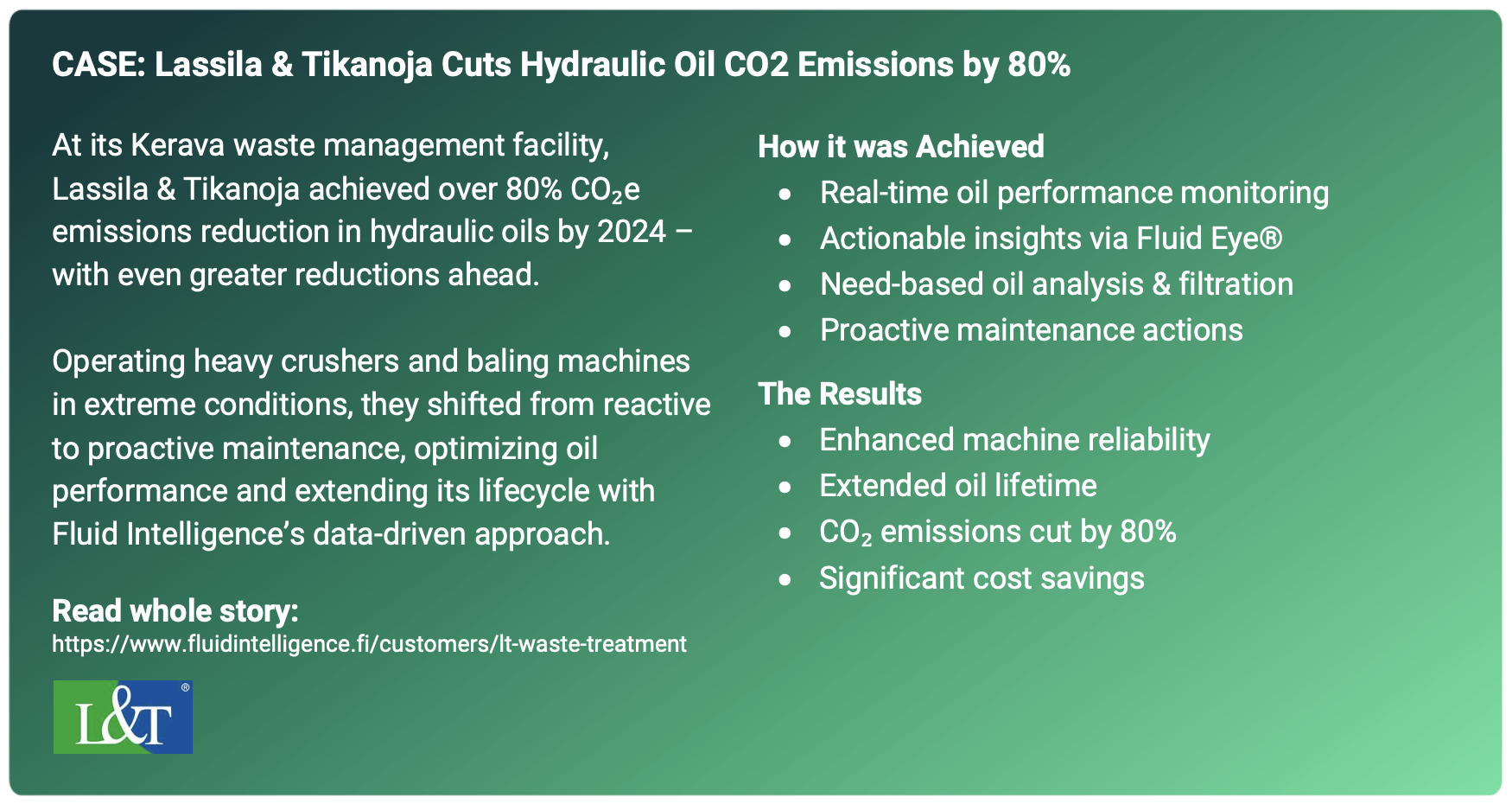Achieving Net Zero Lubrication
Achieving Net Zero Lubrication
A Practical Guide
Net Zero Lubrication Article series
In our previous articles, we discussed #1 emissions fundamentals, #2 regulatory frameworks, and #3 the hidden CO₂ footprint of lubricants. Now, we shift our focus to solutions – how to move from insight to action and achieve #4 Net Zero Lubrication.
The journey to Net Zero Lubrication is not just about sustainability – it’s about maximizing operational reliability and reducing costs. This approach integrates a structured process that businesses can adopt step by step, adapting to their needs and existing capabilities.
The Net Zero Lubrication Process
Achieving Net Zero Lubrication follows a structured three-step approach (see Figure 1.). Each phase is designed to optimize lubrication performance, minimize emissions, and enhance cost efficiency.
Figure 1. Net Zero Lubrication Process and Key Building Blocks
Lubrication Planning: Net Zero Lube Lifecycle Assessment
The first step is to understand the current state of lubrication performance and identify opportunities for improvement. Through a Net Zero Lube Lifecycle Assessment (LCA), we analyze historical data, oil consumption trends, and potential emission reductions. This phase provides a clear roadmap for achieving Net Zero, helping companies set realistic targets and understand how far they can go with the right lubrication strategy and proper lubricant selection.
In-Service Performance Optimization: Maximizing Lube Lifetime and Machine Uptime
Once the plan is in place, the focus shifts to keeping lubricants and machinery performing at their peak. By implementing lab analysis, real-time oil condition monitoring, and optimized maintenance practices like contamination control and chemical top-ups, businesses can extend lubricant lifespan, reduce unnecessary oil changes, and enhance equipment reliability. The goal is to extend oil lifetime while maximizing machine uptime.
Minimizing Waste: Closing the Loop Through Emission Management
The final step is to close the loop – ensuring that used oil is handled in the most sustainable way. This means advising on waste oil recycling, prioritizing regeneration into new base oils rather than combustion, and providing emission offset credits if residual emissions remain. Companies can choose how far they want to go, progressively reducing their carbon footprint over time.
The Net Zero Lubrication model is flexible. If a company already has established processes – such as lab analysis program or oil filtration – this approach complements these activities by offering holistic visibility into the entire lubrication lifecycle, integrating both Lube Performance Optimization and Emission Management to ensure a comprehensive approach to sustainability and reliability. Organizations can start small with just a lifecycle assessment and roadmap, or implement a full-scale strategy from day one.
Key Building Blocks of Net Zero Lubrication
As the innovators of the Net Zero Lubrication model, Fluid Intelligence facilitates this journey by delivering tailored solutions at every step. This structured process can be implemented with six key service components:
Lube Performance Optimization
Lab-based Lube Health & Oil Data Management – Centralized oil health tracking and benchmarking.
Real-time Oil Condition Monitoring – IIoT-powered insights into oil performance trends.
Oil Re-conditioning Systems – Filtration, chemical top-ups, and site-specific solutions.
Lube Emission Management
Emission Simulation – LCA-driven planning for long-term reductions.
Emission Mitigation – Guidance on oil recycling and CO₂ offset strategies.
Emission Reporting – Transparent tracking and reporting at machine, fleet, and enterprise levels.
Benefits and Challenges of Implementation
The Net Zero Lubrication model offers multiple advantages:
✅ Lower emissions – Cut lubricant-related CO₂ and support sustainability goals.
✅ Cost efficiency – Reduce lubricant consumption and maintenance costs.
✅ Improved reliability – Extend machine uptime with better oil performance.
Transitioning to this model is a straightforward process with immediate benefits. While there are some initial investments, these are typically quickly offset by savings from reduced oil consumption, maintenance work and improved uptime. Adapting to new data-driven maintenance processes may seem like a shift, but Fluid Intelligence’s solution aligns seamlessly with existing operations, integrating gradually without disrupting workflows. This means companies can start small, implementing changes step by step at their own pace, while immediately seeing improvements in reliability, cost efficiency, and sustainability. Table 1. describes main differences between traditional and Net Zero Lubrication approaches.
Table 1. Traditional vs. Net Zero Lubrication Approach
Real-Life Examples
The Business Impact
Achieving Net Zero Lubrication delivers real and measurable value to businesses. Beyond environmental benefits, this model enhances operational efficiency, reduces costs, and ensures compliance with evolving regulations.
Regulatory Compliance – Stay ahead of evolving sustainability requirements while actively reducing CO₂ emissions and ensuring long-term compliance.
Operational Efficiency – Improve asset reliability and reduce failures.
Financial Performance – Cut unnecessary oil consumption and related costs.
Key Takeaways
Net Zero Lubrication is achievable with a structured, step-by-step approach.
Companies can start small and integrate solutions gradually.
The model delivers benefits beyond sustainability – enhancing reliability and cost efficiency.
Navigating the Future Together
The transition to Net Zero Lubrication is not just an environmental decision – it’s a business opportunity. Fluid Intelligence’s solutions make achieving Net Zero Lubrication easy and cost-effective, supporting your sustainability goals while optimizing operational performance. By optimizing lubrication management, companies can cut costs, enhance reliability, and lead the way in industrial sustainability. Whether starting with a simple assessment or a full-scale strategy, every step towards Net Zero Lubrication matters.
References and Sources
ISO 14040 - Environmental management — Life cycle assessment — Principles and framework
ISO 14044 - Environmental management — Life cycle assessment — Requirements and guidelines
UEIL & ATIEL - Methodology for PCF Calculations of Lubricants and other Specialities
API - Technical Report 1533 - Lubricants Life Cycle Assessment and Carbon Footprinting
Disclaimers
The views expressed in this article are those of the authors. We regret for any unintentional errors, omissions, or misinterpretations.
Author: Mika Perttula (CEO - Fluid Intelligence Oy)
*** KEEP ON READING ABOUT NET ZERO LUBRICATION ***
Net Zero Lubrication is a strategic mindset and model helping industrial companies to maximize operational performance while minimizing fluid-based CO2 emissions and costs. This model is based on managing the entire lubrication lifecycle from Emissions Management and Fluid Performance Optimization perspectives in three stages - 1) Lubrication planning, 2) In-Service oil lifecycle and performance maximization, and 3) End-of-life waste oil management.
Continue reading Net Zero Lubrication articles to gain deeper insights how companies are optimizing their businesses to become more sustainably compliant, competitive, and profitable. Go to Net Zero Hub.





